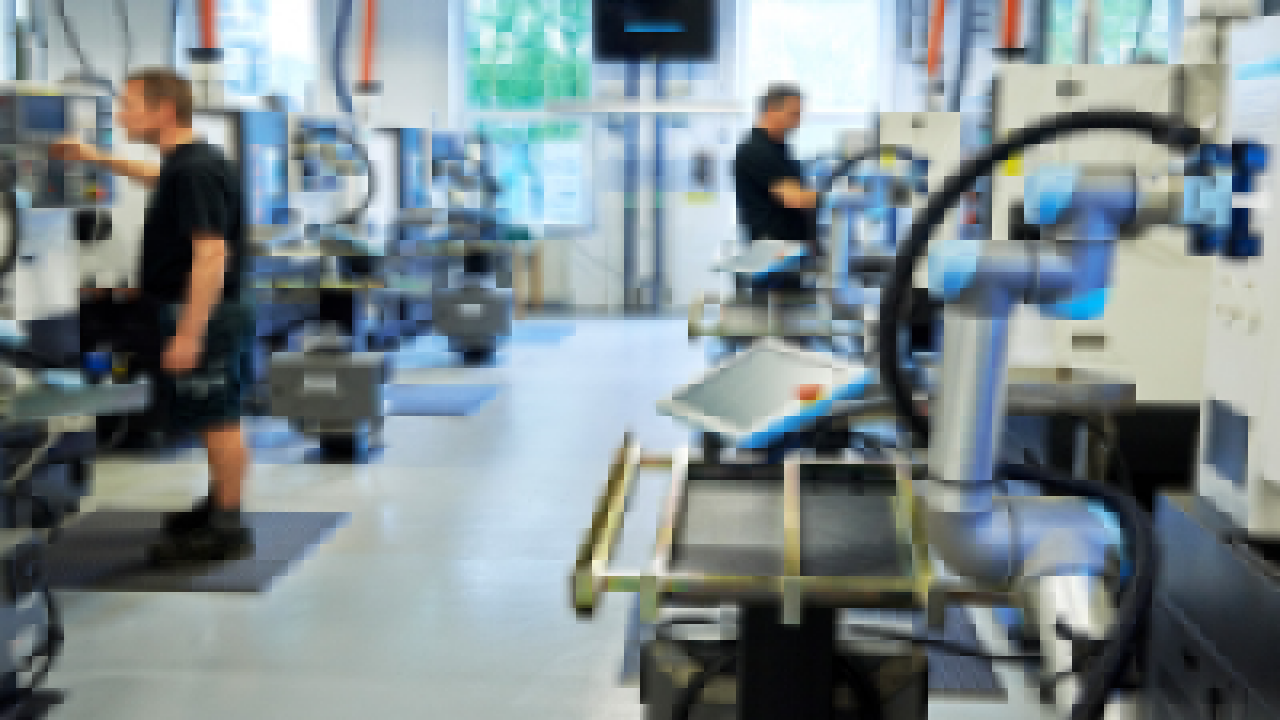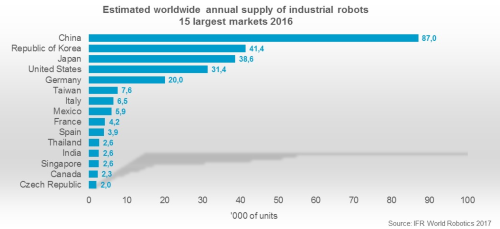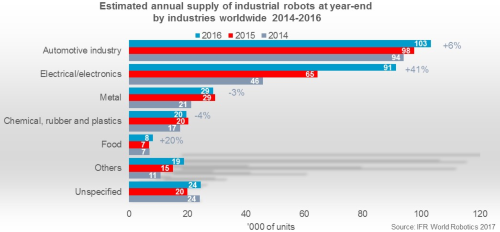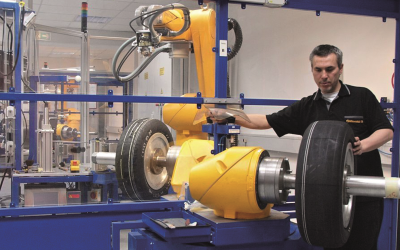Evolution in Industrial Robots
Article By : Ann R. Thryft

Growth in industrial robot sales is waning, but technology is getting far more intricate and useful
BOULDER CREEK, Calif. — Robots that vacuum our floors, talk to us in malls, or disable IEDs may be more interesting to think about, but the industrial robots that put together cars and do pick-and-place on assembly lines are worth far more in total dollar value.
They’re also making more and more of the industrial, commercial and consumer goods we use. Some recent research reports on trends in industrial robots say demand is growing especially in Asia and especially in electronics manufacturing, and technology will give these robots a lot more abilities in the next few years.
The key study is from the International Federation of Robotics (IFR), based in Germany. According to the IFR’s World Robotics: Industrial Robots 2017 report, global unit sales of industrial robots increased at an average of 12 percent per year between 2011 and 2016, with a 16 percent increase in 2016 over 2015.
Asia is still the fastest-growing market in the world for these bots. Unit sales there rose by 19 percent in 2016, compared to 12 percent in Europe and 8 percent in the Americas. The sales value of the global market for industrial robots was $13.1 billion in 2016.
China has maintained and expanded its leadership as the biggest industrial robot market for several years, growing at an average of 31 percent per year between 2011 and 2016.

Although the two largest buyers of industrial robots are China and South Korea, China and the U.S. had the two biggest gains in 2016 unit sales at 27 percent and 14 percent, respectively. Sales to Japan rose 10 percent and to South Korea by 8 percent, while sales to Germany, the fifth largest market, were flat. These five countries constituted 74 percent of the total sales volume in 2016 for industrial robots.
Automotive manufacturing (35 percent) and electrical/electronics manufacturing (31 percent) continue to be the two biggest users of industrial robots worldwide. Compared to automotive’s slow growth of only 6 percent in 2016, electrical/electronics usage has been rising rapidly during the last couple of years: unit sales were up 41 percent since 2015. In most Asian markets this industry sector is now the biggest robot user.
The IFR report points out that looking only at the total number of units sold in a given market can be misleading if the different sizes of manufacturing industries in different countries aren’t taken into account. To give a more accurate picture, analysts calculated industrial robot density per 10,000 employees in manufacturing for 2016. The global average density was 74 industrial robots installed per 10,000 employees.

Source: International Federation of Robotics/Universal Robots
By world regions, industrial robot density is highest in Europe at 99, followed by 84 in the Americas, and 63 in Asia. By country, Singapore’s overall robot density is 488, followed by Germany at 309, Japan at 303, 189 in the U.S., and 68 in China.
Although China’s figure may seem low considering its dominance in total volumes, that’s a big increase since the figure of 25 in 2013. But it also points to how far China must go to achieve its goal of achieving advanced manufacturing, including Industry 4.0-style automation, as part of its Made in China 2025 initiative.
But the highest level in the world of industrial robot density is South Korea’s 631. The report says this is caused by heavy increases in industrial robot installations for both electrical/electronics manufacturing, due to this country’s market leadership in LCD, memory chip and automotive manufacturing. The automotive industry itself is so highly automated that in South Korea its robot density is 2,145. In the U.S. and Japan it’s 1,261 and 1,240, respectively.

Between 2018 and 2020, the number of worldwide industrial robots in operation is expected to grow at an average of 15 percent per year. In the U.S., the main drivers for continued growth since 2010 have been the ongoing automation of production to strengthen American industrial competitiveness in overseas markets, with investments made both to keep manufacturing onshore and to bring it back from overseas locations where it had previously been relocated. This trend has been especially strong in the automotive sector. Most industrial robots used in the U.S. are imported from Japan, Korea, and Europe.
According to IDC robotics analysts, several technologies will bring new abilities to industrial robots, and other types, in the next few years. By 2020, 45 percent of newly installed industrial robots will have at least one intelligent feature, such as predictive analytics, health condition awareness, self-diagnosis, peer-learning, or autonomous cognition. This is one of IDC’s “Top 10 Worldwide Robotics Predictions”, also given in a presentation last November 2017 by Jing Bing Zhang, IDC’s research director for worldwide robotics, and John Santagate, research director for service robotics.

Source: International Federation of Robotics/Staubli
“These are not so much new technologies as they are additional technologies — machine learning, intelligence, industrial internet of things connectivity, and predictive maintenance because of that connectivity — being layered onto existing robotics technologies,” said Santagate. Another prediction is that by 2021, intelligent robotics agents will supervise and coordinate industrial robots, boosting their overall efficiency by 30 percent.
Another report, made last year by Allied Market Research, measures robot growth primarily in dollar value, not units, and slices up industries somewhat differently from the IFR. The firm’s Industrial Robotics Market Report forecasts that the global industrial robotics market will grow from a value of $27 million in 2012 to $41 billion by 2020, at a compound annual growth rate (CAGR) of 5.4 percent between 2013 and 2020.
While automotive manufacturing is the largest user of industrial robots, analysts expect its growth to slow to a CAGR of only 4.9 percent during the period, caused by slowdown in the automotive industry during the past few years. Use of industrial robots in the food & beverages sector is expected to grow faster, at a CAGR of 6.9 percent between 2013 and 2020.
— Ann R. Thryft is the industrial control & automation designline editor at EETimes.
Subscribe to Newsletter
Test Qr code text s ss


